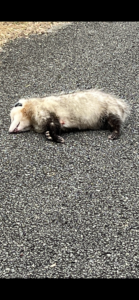 When I cranked open my window blinds on the cold, cold morning of January 5, something in the middle of the road caught my eye. It almost certainly wasn’t a cluster of leaves or a dirt clod or a wadded-up Taco Bell sack.
When I cranked open my window blinds on the cold, cold morning of January 5, something in the middle of the road caught my eye. It almost certainly wasn’t a cluster of leaves or a dirt clod or a wadded-up Taco Bell sack.
This was an animal. A gray animal. An animal that appeared to be stone-cold dead.
“Please don’t let it be Watson,” I murmured before realizing it couldn’t be my prone-to-wander-even-though-he’s-neutered gray cat. Just a couple of minutes earlier, I’d dumped a scoop of friskies into Watson’s bowl on the back porch and he’d come running. It definitely wasn’t my dog Kamala, who’s mostly black and way bigger than this dead critter and who was standing right beside me looking out the window.
I pulled on shoes and a coat and headed down the driveway to find out for certain what this animal was. Raccoon? Rabbit? Squirrel?
It was none of those things. Lying on its right side with eyes closed was a perfectly intact possum. There wasn’t a mark or a drop of blood on it, but it definitely wasn’t playing possum. It almost certainly had been hit by a driver coming too fast down my dead-end road sometime in the night.
My mind harkened back to a scene from several years ago when I’d come upon a dead possum in a gutter just off the square in Cookeville. That discovery happened not on a winter morning but on a sweltering July afternoon. The possum was flat on her back with all four feet pointing to the sky. Tiny, blind babies were crawling out of her pouch into the suffocating heat and making pitiful little sneezing noises as I stood above them in horror, knowing there was nothing I could do to make this okay.
But back to last January. I crouched down over the possum and saw no pouch and no babies, thank goodness. Should I fetch my snow shovel, which I seldom use for snow but which comes in handy in lots of other situations, and move this poor dead creature into the woods? Should I get a real shovel and bury it? That would be hard because even if the ground wasn’t frozen, which it was, I’m not a good digger. Or should I leave the possum where it lay and simply observe (and record) what happened?
That’s the option I chose.
For several days, I watched as vehicles—neighbors and friends, delivery vans, garbage trucks and the occasional curious sightseer—travelled up and down the road. Amazingly, all managed to dodge the possum. The weather stayed really cold so there was no discernable “something has died” odor. Then snows came and for an entire week the possum lay covered in white, still undisturbed. And though turkey buzzards showed some interest, they never gathered to feast, perhaps because the possum hadn’t softened enough for them to dig in.
What did arrive to feast was a solitary red-tailed hawk. It tore into the possum’s belly and scattered and ate the guts. Then it went to work pulling off the hide, going for the flesh, I assume. When the possum was light enough to carry, the hawk clutched it with strong talons and flew onto a branch of a nearby tree. As I moved closer to watch, the bird spooked. What was left of the possum crashed to the pavement but missed me. (Yay!) That was the last I saw of the hawk.
For weeks, the possum’s head and feet and ribcage and random clumps of fur lay in the ditch beside the road. Buzzards came and went without enthusiasm. Now, five months later, all that’s left is the tail. You’d never notice it among the leaves and sticks and gravel and grass clippings unless you were looking for it, which I still am.
Because when Mother Nature hands you a column topic, you’d better jump on it.
(June 8, 2024)